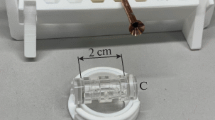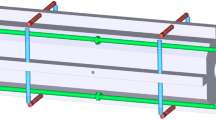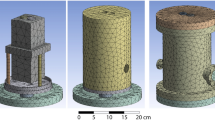Abstract
The capability of optical reference cavities to resist ambient thermal fluctuations is significant in ultrastable laser systems especially applying in transportable system and space station. To reduce the deterioration of long-term laser frequency stability induced by temperature variation, the thermal response of cavities is investigated. The simulation and analysis indicate that the use of multiple enclosing thermal shields with a low emissivity allows a larger thermal time constant. The quantitative functional relationships between the thermal time constant and the heat capacity and surface emissivity of the passive thermal shields are firstly obtained using FEA simulation. Based on these results, a temperature-insensitive cavity system is designed with a thermal time constant of approximately 680 h. According to the designed system, two different methods are used to evaluate the thermal performance. And mathematical expressions for the cavity temperature over time are obtained. The calculated thermal time constant is validated by the simulated results. The thermal sensitivity of the designed system is 4.1 × 10−11 and 1.3 × 10−5 when temperature variation period is 1 h and 24 h, respectively. The fractional length instability of the cavities induced by temperature fluctuation is 8.2 × 10−16 over an average time of 1 day, which can compete theoretically with fountain clocks.



Similar content being viewed by others
References
T M Fortier, N Ashby, J C Bergquist, M J Delaney, et al. Phys. Rev. Lett.98 070801 (2007)
I Ushijima, M Takamoto, M Das, T Ohkubo, and H. Katori Nat Photonics9 185 (2015)
B J Bloom, T L Nicholson, J R Williams, S L Campbell, et al. Nature506, 71 (2014)
N Hinkley, J A Sherman, N B Phillips, M Schioppo, et al. Science341 1215 (2013)
S G Turyshev Phys. Uspekhi52 1 (2009)
H Müller, S Herrmann, C Braxmaier, S Schiller and A Peters Phys. Rev. Lett.91 020401 (2003)
R W P Drever, J L Hall, F V Kowalski, J Hough, G M Ford, A J Munley and H Ward Appl. Phys. B31 97 (1983)
A D Ludlow, X Huang, M Notcutt, T Zanon-Willette, et al. Opt. Lett.32 641 (2007)
B C Young, F C Cruz, W M Itano, and J C Bergquist Phys. Rev. Lett.82 3799 (1999)
T Kessler, C Hagemann, C Grebing, T Legero et al. Nat. Photonics6 687 (2012)
T Nicholson, M Martin, J Williams, B Bloom et al. Phys. Rev. Lett.109 230801 (2012)
Y Y Jiang, A D Ludlow, N D Lemke, R W Fox et al. Nat. Photonics5 158 (2011)
S Hafner, S Falke, C Grebing, S Vogt et al. Opt. Lett.40 2112 (2015)
J Zhang, W Wu, X H Shi, X Y Zeng and Z H Lu Rev. Sci. Instrum.87 023104 (2016)
C Hagemann Ph.D. thesis (University of Hannover, Germany) (2013)
Acknowledgements
This work is supported by the Major Scientific Instruments and National Development Funding Projects of China (Grant No. 61127901), the Key Research Program of the Chinese Academy of Sciences (Grant No. KJZD-EW-W02), the ‘Cross and Cooperative’ Science and Technology Innovation Team Project of the Chinese Academy of Sciences (Grant No. (2012)119) and the Young Scientists Fund of the National Natural Science Foundation of China (Grant No. 11403031). And the work is also supported by Open Research Fund of State Key Laboratory of Transient Optics and Photonics, Chinese Academy of Sciences.
Author information
Authors and Affiliations
Corresponding authors
Additional information
Publisher's Note
Springer Nature remains neutral with regard to jurisdictional claims in published maps and institutional affiliations.
Rights and permissions
About this article
Cite this article
Chen, L., Zhang, L., Jiang, C. et al. Investigation on temperature-insensitive cavity systems for ultrastable lasers. Indian J Phys 94, 397–402 (2020). https://doi.org/10.1007/s12648-019-01483-x
Received:
Accepted:
Published:
Issue Date:
DOI: https://doi.org/10.1007/s12648-019-01483-x




